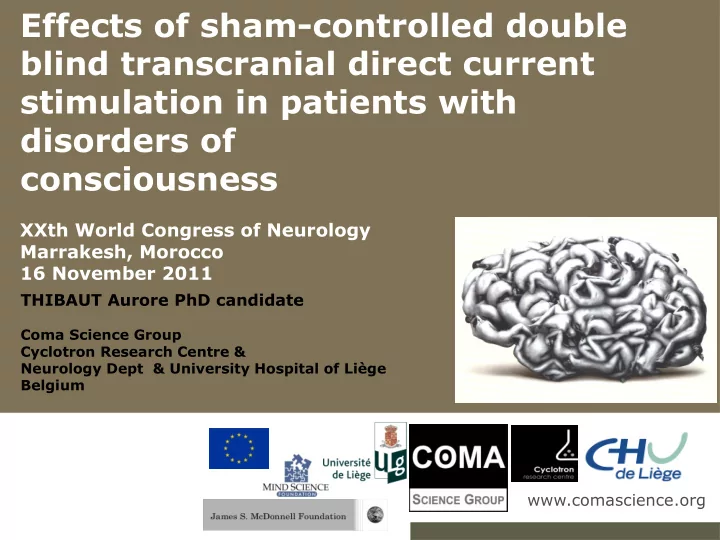

Effects of sham-controlled double blind transcranial direct current stimulation in patients with disorders of consciousness XXth World Congress of Neurology Marrakesh, Morocco 16 November 2011 THIBAUT Aurore PhD candidate Coma Science Group Cyclotron Research Centre & Neurology Dept & University Hospital of Liège Belgium www.comascience.org
disorders of consciousness | behavioural evaluation | electrophysiology | neuroimaging | methods, ethics & quality of life | perspectives Introduction | Materials and Methods | Results │ Discussion Patients VEGETATIVE COMA NORMAL MINIMALLY STATE/ CONSCIOUSNESS CONSCIOUS UNRESPONSIVE STATE WAKEFULNESS SYNDROME AWARENESS AWARENESS AWARENESS AWARENESS AROUSAL AROUSAL AROUSAL AROUSAL Laureys, Owen and Schiff Lancet Neurology, 2005 www.comascience.org Laureys et al, BMC Medicine 2010 Demertzi et al, Exp Rev Neurother, 2008
Introduction | Materials and Methods | Results │ Discussion Why direct current stimulation? Stimulation Population Effects Authors Prefrontal Healthy subjects Memory Marshall et al, J Neurosci 2004 cortex Alzheimer’s patients Memory Ferrucci et al, Neurology 2008 Stroke patients Attention Jo et al, Am J Phys Med Rehabil 2009 Aphasic patients Language Baker et al, Stroke 2010 • Non-invasive • Easy to apply • Cheap equipment www.comascience.org
disorders of consciousness | behavioural evaluation | electrophysiology | neuroimaging | methods, ethics & quality of life | perspectives Introduction | Materials and Methods | Results │ Discussion AIM of the study To assess tDCS effects on cognition in patients with disorders of consciousness www.comascience.org
Introduction | Materials and Methods | Results │ Discussion Methods Design: sham-controlled double blind 4 CRS-R: pre-post tDCS/pre-post sham Patients 55 patients (16 women; aged 43 ± 18 y) 25 VS/UWS, 30 MCS 25 traumatic / 30 non-traumatic DC Stimulator Plus Outcome measure Coma Recovery Scale-Revised (CRS-R, Giacino 2004) Hypothesis: tDCS responders: CRS-R total tDCS > pre-tDCS, sham, pre-sham Statistical analysis: ANOVA (Stata) www.comascience.org
Introduction | Materials and Methods | Results | Discussion | Group data (n=55) ** * Interactions • MCS>VS, p=0.026 • Acute> chronic, p=0.004 • Etiology, p=0.37 0 ** p<.001 pre tDCS post tDCS pre sham post sham * p <.05 www.comascience.org
Introduction | Materials and Methods | Results | Discussion | VS/UWS vs. MCS MCS VS/UWS * 23 23 17 responders 22 22 21 21 • 15 MCS (7 acute,8 chronic) 20 20 19 19 • 2 VS/UWS (acute) 18 18 17 17 16 16 15 15 CRS-R scores CRS-R scores 14 14 13 13 12 12 11 11 10 10 9 9 8 8 7 7 6 6 5 5 4 4 Trauma 3 3 Non trauma 2 2 Chronic 1 1 0 0 Acute pre tDCS post tDCS pre tDCS post tDCS 1 2 1 2 www.comascience.org
disorders of consciousness | behavioural evaluation | electrophysiology | neuroimaging | methods, ethics & quality of life | perspectives Introduction | Materials and Methods | Results | Consclusions Conclusions - Deep Brain Stimulation (Schiff et al., Nature 2008) - Amantadine (Schnakers, 2008) - Non-invasive non-pharmacological class A evidence for tDCS induced cognitive improvement in MCS www.comascience.org
THANK YOU www.comascience.org Questions to: athibaut@chu.ulg.ac.be
Responders 25 VS/UWS 2 responders 2/11 VS/UWS acute 0/14 VS/UWS chronic 30 MCS 15 responders 7/9 acute 8/21 chronic www.comascience.org
Responders: audition subscale * * Consistent movement to command Reproducible movement to command Localisation of sounds Auditory startle None pre tDCS post tDCS pre sham post sham www.comascience.org
Responders: subscales - visual * * Object recognition Reaching Visual pursuit Fixation Visual startle None pre tDCS post tDCS pre sham post sham www.comascience.org
tDCS parameters and safety U=R*I Intensity: 2mA Time: 20 minutes 2mA et 10kOhm Voltage: max 26V = 20V OK 2mA and 20kOhm Electrodes: 35cm² = 40V STOP Max: 0.1mA/cm² www.comascience.org
tDCS presumed mode of action Direct effects Modification of neuronal excitability Long term effects Modification of ion channels (Na + , Ca 2+ ) Modification of NMDA receptors efficacy Modification of inter-neurons still hypothesis Nitsche et al., J Physiol 2000 Nitsche et al., Neuroscientist 2010 www.comascience.org
tDCS critisisms Limitations: Short term effect Moderate clinical change Unknown physiological effects (cathode) Improve electrode position? www.comascience.org
Recommend
More recommend